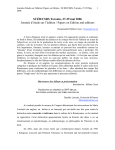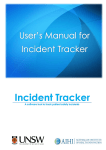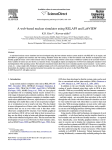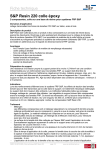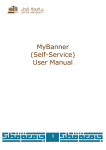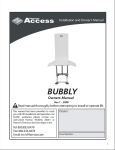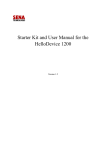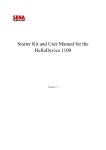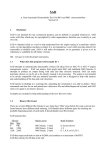Download - International Journal of Medical Informatics
Transcript
International Journal of Medical Informatics (2003) 71, 151—156 SHORT COMMUNICATION Web-based remote monitoring of infant incubators in the ICU D.I. Shin a , S.J. Huh a,*, T.S. Lee b , I.Y. Kim c a Department of Biomedical Engineering, Asan Medical Center and University of Ulsan College of medicine, 388-1 PungNap-Dong, SongPa-Gu, Seoul 138-736, South Korea b Department of Biomedical Engineering, College of Medicine, Chungbuk National University, ChungJu, South Korea c Department of Biomedical Engineering, College of Medicine, Hanyang University, Seoul, South Korea Received 26 March 2003 ; received in revised form 13 June 2003; accepted 13 June 2003 KEYWORDS Web-based; Intranet; Infant incubator; Intensive Care Unit (ICU); Monitoring Summary A web-based real-time operating, management, and monitoring system for checking temperature and humidity within infant incubators using the Intranet has been developed and installed in the infant Intensive Care Unit (ICU). We have created a pilot system which has a temperature and humidity sensor and a measuring module in each incubator, which is connected to a web-server board via an RS485 port. The system transmits signals using standard web-based TCP/IP so that users can access the system from any Internet-connected personal computer in the hospital. Using this method, the system gathers temperature and humidity data transmitted from the measuring modules via the RS485 port on the web-server board and creates a web document containing these data. The system manager can maintain centralized supervisory monitoring of the situations in all incubators while sitting within the infant ICU at a work space equipped with a personal computer. The system can be set to monitor unusual circumstances and to emit an alarm signal expressed as a sound or a light on a measuring module connected to the related incubator. If the system is configured with a large number of incubators connected to a centralized supervisory monitoring station, it will improve convenience and assure meaningful improvement in response to incidents that require intervention. © 2003 Elsevier Ireland Ltd. All rights reserved. 1. Introduction Central monitoring systems used in Intensive Care Units (ICUs) are convenient and essential. They enable managing staff to monitor patients’ circumstances using real-time operating system throughout the ICU. However, there is no such central monitoring system in the infant ICU. Staff must walk around and check incubators one by one. *Corresponding author. Tel.: +82-2-3010-5101; fax: +82-2-3010-5290. E-mail address: [email protected] (S.J. Huh). Fortunately, remote supervisory control technology and devices to connect equipment in need of control with the web have created the possibility of studies of web-based monitoring system which have evolved over several decades [1—4]. Of course, some computerized data acquisition methods for infusion devices were already attempted [5]. On the other hand, web-server board controlling devices of every kind have been commercialized for popular use with web-based systems. A web-server board offers great convenience to users who need to connect and control existing equipment [6]. 1386-5056/$ – see front matter © 2003 Elsevier Ireland Ltd. All rights reserved. doi:10.1016/S1386-5056(03)00095-9 152 The aim of study is to help to manage and monitor conditions within incubators in the infant ICU using the hospital network to overcome space limits that restrict available room for controlling equipment and to enable immediate response to unusual circumstances. Accordingly, we developed a module for measuring temperature and humidity within an infant incubator and installed it in four incubators. We connected these to a web-server board using an RS485 interface. A web document based on the Java programming language was created on the web-server board. The document gathers temperature and humidity data and transmits it to the client. To assure data security, the web document can be accessed only with an authorized ID and password. 2. Methodology 2.1. System organization 2.1.1. Measuring module Internal temperature and humidity are the most important conditions that need to be monitored in an infant incubator. Therefore, most incubators have their own temperature and humidity sensor built-in and have a function of signal interfacing to a PC or other devices on the outside of the incubator [7]. Development of our monitoring system called for creating a new measuring module for checking temperature and humidity, as different standard interfaces and signaling protocols are used by the various existing modules. To achieve this aim, we used a platinum resistance temperature detector as the temperature sensor because it is small and easy to install in an incubator and it measures straight-line resistance/temperature over a relatively wide temperature range, especially within the 30—40 ◦ C range needed to monitor the temperature of an incubator [8]. In practice, the measuring network provides constant-current to the platinum resistance temperature detector and measures its electric potential difference, which is converted to a digital value between 0 and 255 by a micro-controller in the measuring module and is then calculated as the actual temperature by a correction algorithm. This measuring module stores the actual temperature and humidity value or transmits its data on demand of the web-server after processing of the correction algorithm and after converting the analog signal from the temperature and humidity sensors to a digital signal. The degree of accuracy may be influenced by var- D.I. Shin et al. ious factors including deviation of the sensor, the precision of the amplifier, and error introduced by the A/D converter [9]. Therefore, this system has a measurement range limit such that the degree of accuracy in indicating temperature is 0.1 ◦ C and the measuring range of incubator temperature is narrow: approximately 30—40 ◦ C. To solve this problem of inaccuracy, a correction algorithm for the final-obtained temperature data was used to keep the precision of measured temperature in the incubator at a fixed temperature within an indicating precision of 0.1 ◦ C. The case of humidity was handled in the same way. These correction algorithms are performed in a 8 bit micro-controller (PIC16C73) [10]. As the overall block-diagram represents, a measuring module is installed at each location that needs monitoring. This suggests that if the managing staff wants to conduct web-based remote supervisory control of the all 32 incubators in the infant room, they should connect one web-server on the web with 32 measuring modules. In according to this method, an RS485 mode was applied to the measuring modules and the web-server board. MAX485 was selected for operating the RS485 interface, which sends and receives using only one transmission channel in a half-duplex mode. The interface consists of an 8 pin-package, so that it is possible to connect up to 128 lines at most, while also allowing miniaturization of the modules. Fig. 1 shows a block-diagram of each module. Fig. 2 shows the interface between the module and the web-server. Fig. 3 shows a connection diagram of the RS485 multi-interface in the applied half-duplex mode. The half-duplex mode has both merit and demerit. The advantage that a transmission channel can operate using just two lines. This advantage must be weighed against the limitation that only one master on the sending side can operate at any given time. The termination resistance (120 ) for impedance matching was set to connect to both the start point and end point of the transmission channel. Also, 26AWG twisted line with an impedance 12 was used to optimize transmission conditions [11]. There was no distance limit owing to the technical ability to transmit up to 1200 m, which was sufficient for our needs. Again, the purpose of this research is the central monitoring of infant incubators with simple attachment of our sensors. So, we would not modify the inner circuits of infant incubators as possible. 2.1.2. Web-server The data from each measuring module is transmitted to the web-server via the RS485 multi-interface. Remote monitoring of infant incubators in the ICU Fig. 1 153 A block-diagram of the acquisition module. Fig. 2 Interface between web-server and acquisition modules. The web-server specifications are as follows: • 8 bits, 50 MIPS processor, SX52BD; • 512KB flash memory storing web resource and control variable; • 10 Base-T Ethernet interface with RJ45 jack; • TCP/IP stack and built-in web-server firmware; • RS232/485 interface (maximum safe speed of 38 400 baud). IP control and change and upload of web resources on a Windows-based (running 95/98/NT/ 2000) PC can be accomplished with a web-server having an Ethernet controller, RS232/485 serial interface, and 512KB flash memory built-in and operated by an 8 bit microprocessor as Fig. 4 rep- Fig. 3 Fig. 4 A block-diagram of the web-server board. resents. The device plays an independent role providing the basic functions of a web-server. 2.1.3. Overall system organization The overall system map is shown as Fig. 5. The measuring module for each incubator is connected to a web-server board via an RS485 port. A Java program on the web-server board requests data transmission from each measuring module cyclically. Data transmitted to the web-server board is expressed in the form of a number or a graphic display on a PC screen connected to the web. Our study used a web-server board capable of having 64 measuring modules at most, which enabled it to connect with only four incubators. The Multiple interfaces of the RS485. 154 D.I. Shin et al. Fig. 5 A block-diagram of whole system. power source for the measuring modules was 9 V supplied by a separate switching power supply for each module. The 9 V was then converted to 5 V by a regulator in each measuring module. 2.2. System operation 2.2.1. Web-server operation Two process are needed to operate the web-server. The first involves controlling the web-server board, including network registration of and identification of web resources. The second involves making the web resource respond to the client’s demand. The web sever is controlled by standard utility software supplied by the manufacturer. The software enables utility software to enter a designated hardware address on the PC and register the authorized IP address for firmware in the web-server with the hospital’s network. This allows the compound web-server to be recognized as a single server on the hospital’s network and allows upload of web-based resources operating on the web-server to devices on the PC network. The web resource performs its assigned task, which is to gather temperature and humidity data from the measuring modules installed in the incubators connected to the RS485 interface and to then transmit the information to a client in response to the client’s request. The web resource is implemented by adding a Java applet to an HTML base. Once the client accesses the web-server, the Java applet is downloaded to the client, then the web-server requests data transmission from the measuring module connected to the RS485 interface. This request is ini- Fig. 6 Signal protocol between the web-server and a measurement module. tiated by demand of the applet. Finally, temperature and humidity data from the measuring module is returned to the client. The Java applet downloaded to the client can display the overall temperature and humidity conditions from each measuring module or can represent the conditions reported by a measuring module each hour as a graphic diagram. 2.2.2. Signaling protocol Fig. 6 shows the protocol mode that the web-server uses to request data transmission from a specific measuring module upon a client’s request to transmit the ID of the measuring module and command language. The structure and operation of the command language was defined as represented in Table 1. The transmission mode from the measuring module to the web-server was divided into a single transmission mode and a serial transmission mode, for use depending on the type of command received. The serial mode transmits temperature and humidity data stored in the measuring module each hour at one time and aims to show the trend over 12 or 24 h. Table 1 Bit definition of prompts byte Bit 7 Bit 6 Bit 5 Bit 4 Bit 3 Bit 2 Bit 1 Bit 0 D3 D2 D1 D0 B C H T Remote monitoring of infant incubators in the ICU 155 • T (request for temperature date transmission): requesting current temperature data to the measuring module at 1; • H (request for humidity date transmission): requesting current humidity data to the measuring module at 1; • C (request for serial data transmission): requesting serial data to the measuring module at 1; • B (request for emission of alarm signal): requesting emission of alarm signal to the measuring module; • D3—0 (length of serial data = n): requesting temperature and humidity data for the latest 2n h. 2.2.3. Storing and display of measured data To transmit data serially, the measuring module stores temperature and humidity data into FIFO memory (32KB) which is capable of storing temperature and humidity data for 24 h into 8 bits at 15 s intervals. With the exception of the 24 h storage described in the above case, every time the web-server requests a data transmission, the latest temperature and humidity data can be transmitted to it. Moreover, the data from all measuring modules is set to renew once every 10 s and is represented in the form of numbers, which can be sent as a single transmission. The data from each measuring module within the scope of 12 or 24 h time frame can be set to send by serial transmission or to send at one time. It is represented as a graphic display for clients needing to monitor 12 or 24 h trend data. 3. Results of experiment As a result of our experiment, it can be said that management staff can use the web to monitor and manage temperature and humidity within infant incubators. Fig. 7 shows a web-server board connected via RS485 and Fig. 8 shows a measuring module for checking temperature and humidity. In our experiment, we manufactured and connected four measuring modules with the web-server board via the RS485 interface. The control center in the infant ICU can perform primary supervisory control of incubators as circumstances demand. Any place connected to the web network system within the hospital can exercise control. Supervisory control of incubators cannot rely only on this system, however, a central monitoring system conveniently identifies problems needing solution and prompts staff to respond immediately to those problems. Fig. 7 Fig. 8 A photograph of the web-server board. A photograph of a developed acquisition module. 4. Examination and conclusion It is not easy to individually monitor many incubators installed in an infant ICU. The web-based remote supervisory control system developed in our study makes it possible to monitor conditions of incubators from any place within the hospital and to also identify minute changes by monitoring the system’s trend function. Our experiment equipped each of four incubators with a measuring module, and connected the modules to a web-server via a wire interface to a RS485 connector. Using our system, supervisory staff could identify an incubator with unusual conditions and respond immediately to alarms emitted by the system. Our system could be further improved by using a wireless interface eliminate the need for a wire connection (Fig. 9). In conclusion, this study presents a solution to the need for centralized supervisory control and management, especially as use of various types of equipment used in hospitals increases in the future. 156 D.I. Shin et al. Fig. 9 A sample snapshot of web-based incubator monitoring. Acknowledgements This work is the result of research activities of Advanced Biometric Research Center (ABRC) supported by KOSEF. References [1] J.S. Park, W.K. Min, K.S. Lim, T.H. Lim, J.S. Lee, W.S. Kwack, H.I. Cho, Development of web based laboratoryinformation-accessing system, J. Korean Soc. Med. Inform. 5 (1) (1999) 149—155. [2] J.W. Choi, Y.H. Kim, S.K. Lee, J.O. Lee, B.H. Oh, H.I. Cho, A telemedicine system using B-ISDN, J. Korean Soc. Med. Inform. 3 (2) (1997) 141—146. [3] H. Takeda, Y. Matsumura, S. Kuwata, H. Nakano, N. Sakamoto, R. Yamamoto, Architecture for networked electronic patient record systems, Int. J. Med. Inform. 60 (2000) 161—167. [4] A.W. Kushniruk, C. Patel, V.L. Patel, J.J. Cimino, ‘Televaluation’ of clinical information systems: an integrative approach to assessing web-based systems, Int. J. Med. Inform. 61 (2001) 45—70. [5] S.Y. Belal, A.J. Nevill, P. Jeyaratnam, A computerized data acquisition system for infusion devices–—a clinical support tool, or a risk management tool? J. Med. Eng. Technol. 25 (2) (2001) 61—67. [6] F. Magrabi, N.H. Lovell, B.G. Celler, A web-based approach for electrocardiogram monitoring in the home, Int. J. Med. Inform. 54 (1999) 145—153. [7] Infant Incubator Service Manual, Air-shields. [8] K.S. Whang, Case Study of Sensor Application, Kijeon Research Press, 1989, pp. 633—686. [9] A Dictionary of Electronic Circuits, Sewon Press, 1989, pp. 12—155. [10] C.H. Shin, Technical Handbook of PIC16C7X, Comfile Technology Press, 1999. [11] Maxim Semiconductor, a datasheet of MAX485, http:// www.maxim-ic.com, 1999.






